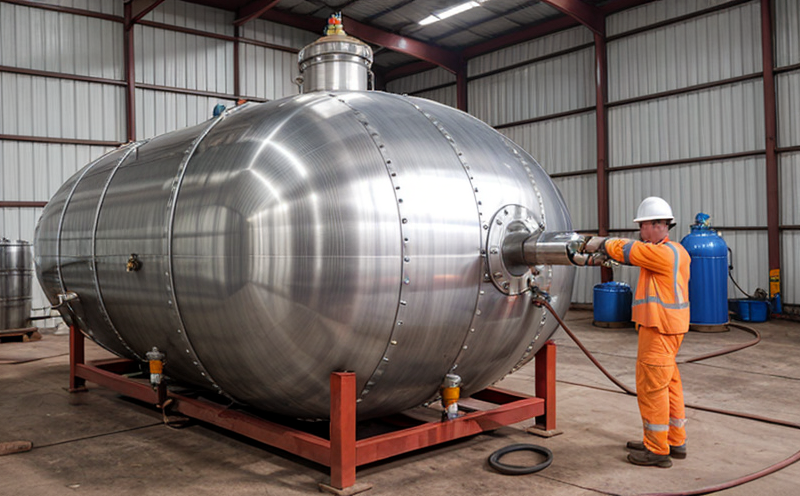Pressure vessel leakage inspection
The pressure vessel leakage inspection is a critical process in ensuring the safety and integrity of vessels that operate under high pressure. These containers are used across various sectors including petrochemicals, pharmaceuticals, food processing, and power generation. The primary objective of this inspection is to detect any potential leaks or defects that could lead to catastrophic failures, thereby safeguarding lives and assets.
Pressure vessels are designed to withstand extreme conditions, but over time, they can experience degradation due to corrosion, erosion, fatigue, and other wear-and-tear factors. Leaks in these vessels can result from a variety of causes such as manufacturing defects, material failure, or operational stress. The inspection process involves the use of non-destructive testing (NDT) methods that allow for the assessment of internal and external surfaces without compromising their structural integrity.
The most common NDT techniques used in pressure vessel leakage inspections include ultrasonic testing (UT), radiographic examination (RT), magnetic particle testing (MT), liquid penetrant inspection (PT), and eddy current testing (ET). Each method has its own advantages depending on the specific requirements of the application. For instance, UT is highly effective for detecting internal flaws while RT can provide a detailed image of defects within the material.
During an inspection, it is crucial to follow established standards such as ASME Section VIII Division 1 and EN 15279, which outline the procedures and acceptance criteria for pressure vessel examinations. These regulations ensure that inspections are conducted consistently across different facilities, promoting reliability and trust within the industry.
The process begins with a thorough assessment of the vessel’s history and operating conditions to identify any potential risks. This includes reviewing past inspection reports, maintenance records, and operational data. Once the initial evaluation is complete, the appropriate NDT technique(s) are selected based on factors like material type, wall thickness, and expected load requirements.
After selecting the right method, the vessel undergoes a series of preparatory steps before undergoing the actual inspection. This may involve cleaning the surface, removing any existing coatings or insulation, and ensuring that all openings are sealed to prevent contamination. During the inspection itself, highly skilled technicians carefully examine every inch of the vessel using advanced equipment. Special attention is paid to areas where failures are most likely to occur, such as weld seams and stress-corrosion cracking regions.
The results of the inspection are meticulously documented and analyzed by our experienced professionals who have extensive knowledge in interpreting NDT data. Any detected issues are reported back to the client along with recommendations for necessary corrective actions. By leveraging our expertise and state-of-the-art technology, we ensure that every pressure vessel passes stringent quality checks before being returned to service.
Our team of certified inspectors adheres strictly to international standards such as ISO 9712 and ASME Section V when conducting these inspections. These guidelines provide clear instructions on how to perform each step correctly, ensuring consistent results throughout the entire process.
Industry Applications
The importance of pressure vessel leakage inspection cannot be overstated in industries where safety is paramount. Petrochemical plants rely heavily on pressurized storage tanks and reactors that handle hazardous chemicals daily. In such environments, even minor leaks can have severe consequences if not addressed promptly.
- Chemical manufacturing facilities
- Petrochemical processing units
- Pharmaceutical production lines
- Power generation stations using steam turbines
In these settings, continuous monitoring of pressure vessels is essential to prevent accidental releases that could endanger workers and surrounding communities. By incorporating regular inspections into their maintenance schedules, companies demonstrate their commitment to maintaining high standards of safety and compliance.
The same principles apply in other sectors such as oil & gas exploration where offshore platforms depend on robust piping systems capable of withstanding harsh oceanic conditions. Similarly, food processing industries must ensure that their equipment remains intact during sterilization processes involving elevated temperatures and pressures.
Eurolab Advantages
At Eurolab, we pride ourselves on offering comprehensive pressure vessel leakage inspection services tailored to meet the unique needs of our clients. Our team consists of highly qualified personnel with years of experience in performing these inspections under strict adherence to relevant codes and standards.
- Dedicated resources: We have dedicated staff members assigned solely to pressure vessel inspections, ensuring that each task receives personalized attention.
- State-of-the-art technology: Leveraging cutting-edge NDT equipment allows us to detect even the smallest flaws with precision and accuracy.
- Comprehensive documentation: Every inspection comes accompanied by detailed reports that include images, measurements, and interpretations of findings, providing clients with clear insights into vessel health.
- Client collaboration: Our experts work closely with customers throughout the entire process, addressing any concerns or questions promptly to ensure satisfaction.
We also offer training programs designed specifically for employees responsible for managing pressure vessels. These sessions cover everything from basic principles of NDT to advanced troubleshooting techniques, empowering participants to handle emergencies confidently.
By choosing Eurolab for your pressure vessel leakage inspections, you gain access to unparalleled expertise and unwavering dedication towards excellence in service delivery. Whether it’s routine checks or complex diagnostic evaluations, rest assured that we will leave no stone unturned until complete reassurance is achieved.





